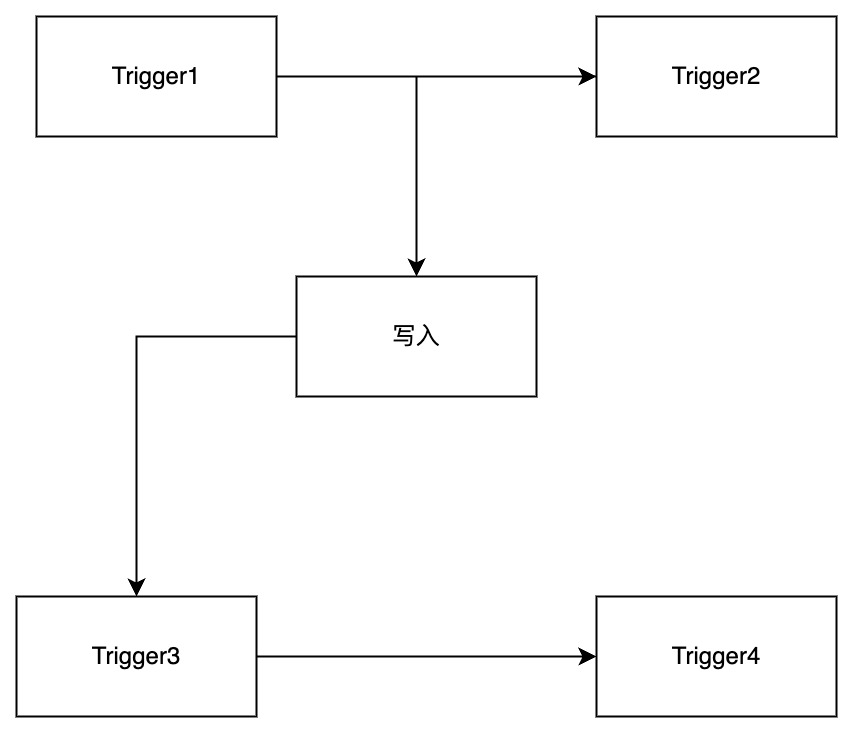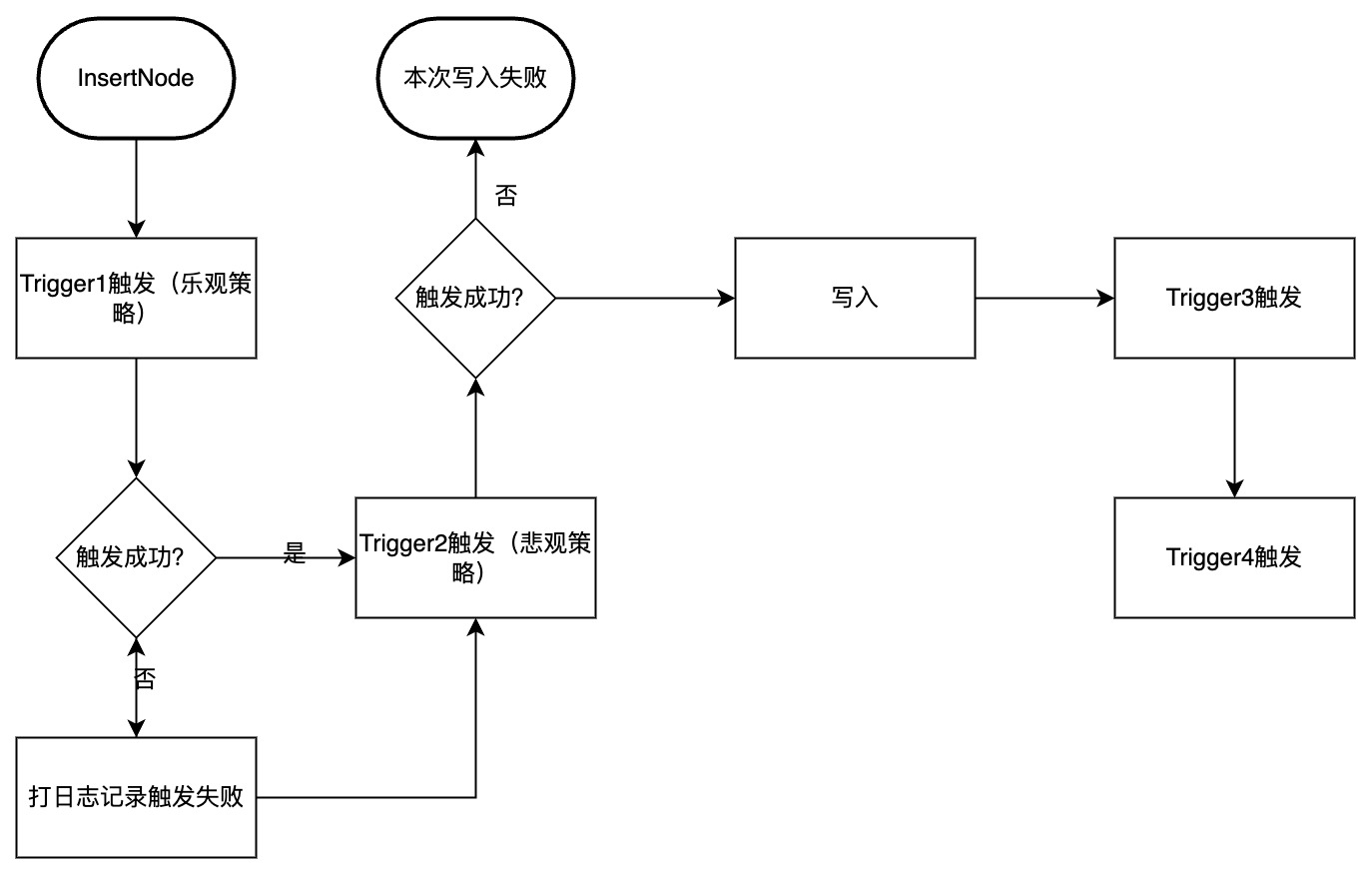触发器
触发器
1. 使用说明
触发器提供了一种侦听序列数据变动的机制。配合用户自定义逻辑,可完成告警、数据转发等功能。
触发器基于 Java 反射机制实现。用户通过简单实现 Java 接口,即可实现数据侦听。IoTDB 允许用户动态注册、卸载触发器,在注册、卸载期间,无需启停服务器。
1.1 侦听模式
IoTDB 的单个触发器可用于侦听符合特定模式的时间序列的数据变动,如时间序列 root.sg.a 上的数据变动,或者符合路径模式 root.**.a 的时间序列上的数据变动。您在注册触发器时可以通过 SQL 语句指定触发器侦听的路径模式。
1.2 触发器类型
目前触发器分为两类,您在注册触发器时可以通过 SQL 语句指定类型:
- 有状态的触发器。该类触发器的执行逻辑可能依赖前后的多条数据,框架会将不同节点写入的数据汇总到同一个触发器实例进行计算,来保留上下文信息,通常用于采样或者统计一段时间的数据聚合信息。集群中只有一个节点持有有状态触发器的实例。
- 无状态的触发器。触发器的执行逻辑只和当前输入的数据有关,框架无需将不同节点的数据汇总到同一个触发器实例中,通常用于单行数据的计算和异常检测等。集群中每个节点均持有无状态触发器的实例。
1.3 触发时机
触发器的触发时机目前有两种,后续会拓展其它触发时机。您在注册触发器时可以通过 SQL 语句指定触发时机:
- BEFORE INSERT,即在数据持久化之前触发。请注意,目前触发器并不支持数据清洗,不会对要持久化的数据本身进行变动。
- AFTER INSERT,即在数据持久化之后触发。
2. 编写触发器
2.1 触发器依赖
触发器的逻辑需要您编写 Java 类进行实现。
在编写触发器逻辑时,需要使用到下面展示的依赖。如果您使用 Maven,则可以直接从 Maven 库中搜索到它们。请注意选择和目标服务器版本相同的依赖版本。
<dependency>
<groupId>org.apache.iotdb</groupId>
<artifactId>iotdb-server</artifactId>
<version>1.0.0</version>
<scope>provided</scope>
</dependency>2.2 接口说明
编写一个触发器需要实现 org.apache.iotdb.trigger.api.Trigger 类。
import org.apache.iotdb.trigger.api.enums.FailureStrategy;
import org.apache.iotdb.tsfile.write.record.Tablet;
public interface Trigger {
/**
* This method is mainly used to validate {@link TriggerAttributes} before calling {@link
* Trigger#onCreate(TriggerAttributes)}.
*
* @param attributes TriggerAttributes
* @throws Exception e
*/
default void validate(TriggerAttributes attributes) throws Exception {}
/**
* This method will be called when creating a trigger after validation.
*
* @param attributes TriggerAttributes
* @throws Exception e
*/
default void onCreate(TriggerAttributes attributes) throws Exception {}
/**
* This method will be called when dropping a trigger.
*
* @throws Exception e
*/
default void onDrop() throws Exception {}
/**
* When restarting a DataNode, Triggers that have been registered will be restored and this method
* will be called during the process of restoring.
*
* @throws Exception e
*/
default void restore() throws Exception {}
/**
* Overrides this method to set the expected FailureStrategy, {@link FailureStrategy#OPTIMISTIC}
* is the default strategy.
*
* @return {@link FailureStrategy}
*/
default FailureStrategy getFailureStrategy() {
return FailureStrategy.OPTIMISTIC;
}
/**
* @param tablet see {@link Tablet} for detailed information of data structure. Data that is
* inserted will be constructed as a Tablet and you can define process logic with {@link
* Tablet}.
* @return true if successfully fired
* @throws Exception e
*/
default boolean fire(Tablet tablet) throws Exception {
return true;
}
}该类主要提供了两类编程接口:生命周期相关接口和数据变动侦听相关接口。该类中所有的接口都不是必须实现的,当您不实现它们时,它们不会对流经的数据操作产生任何响应。您可以根据实际需要,只实现其中若干接口。
下面是所有可供用户进行实现的接口的说明。
生命周期相关接口
| 接口定义 | 描述 |
|---|---|
| default void validate(TriggerAttributes attributes) throws Exception {} | 用户在使用 CREATE TRIGGER 语句创建触发器时,可以指定触发器需要使用的参数,该接口会用于验证参数正确性。 |
| default void onCreate(TriggerAttributes attributes) throws Exception {} | 当您使用CREATE TRIGGER语句创建触发器后,该接口会被调用一次。在每一个触发器实例的生命周期内,该接口会且仅会被调用一次。该接口主要有如下作用:帮助用户解析 SQL 语句中的自定义属性(使用TriggerAttributes)。 可以创建或申请资源,如建立外部链接、打开文件等。 |
| default void onDrop() throws Exception {} | 当您使用DROP TRIGGER语句删除触发器后,该接口会被调用。在每一个触发器实例的生命周期内,该接口会且仅会被调用一次。该接口主要有如下作用:可以进行资源释放的操作。可以用于持久化触发器计算的结果。 |
| default void restore() throws Exception {} | 当重启 DataNode 时,集群会恢复 DataNode 上已经注册的触发器实例,在此过程中会为该 DataNode 上的有状态触发器调用一次该接口。有状态触发器实例所在的 DataNode 宕机后,集群会在另一个可用 DataNode 上恢复该触发器的实例,在此过程中会调用一次该接口。该接口可以用于自定义恢复逻辑。 |
数据变动侦听相关接口
侦听接口
/**
* @param tablet see {@link Tablet} for detailed information of data structure. Data that is
* inserted will be constructed as a Tablet and you can define process logic with {@link
* Tablet}.
* @return true if successfully fired
* @throws Exception e
*/
default boolean fire(Tablet tablet) throws Exception {
return true;
}数据变动时,触发器以 Tablet 作为触发操作的单位。您可以通过 Tablet 获取相应序列的元数据和数据,然后进行相应的触发操作,触发成功则返回值应当为 true。该接口返回 false 或是抛出异常我们均认为触发失败。在触发失败时,我们会根据侦听策略接口进行相应的操作。
进行一次 INSERT 操作时,对于其中的每条时间序列,我们会检测是否有侦听该路径模式的触发器,然后将符合同一个触发器所侦听的路径模式的时间序列数据组装成一个新的 Tablet 用于触发器的 fire 接口。可以理解成:
Map<PartialPath, List<Trigger>> pathToTriggerListMap => Map<Trigger, Tablet>请注意,目前我们不对触发器的触发顺序有任何保证。
下面是示例:
假设有三个触发器,触发器的触发时机均为 BEFORE INSERT
- 触发器 Trigger1 侦听路径模式:root.sg.*
- 触发器 Trigger2 侦听路径模式:root.sg.a
- 触发器 Trigger3 侦听路径模式:root.sg.b
写入语句:
insert into root.sg(time, a, b) values (1, 1, 1);序列 root.sg.a 匹配 Trigger1 和 Trigger2,序列 root.sg.b 匹配 Trigger1 和 Trigger3,那么:
- root.sg.a 和 root.sg.b 的数据会被组装成一个新的 tablet1,在相应的触发时机进行 Trigger1.fire(tablet1)
- root.sg.a 的数据会被组装成一个新的 tablet2,在相应的触发时机进行 Trigger2.fire(tablet2)
- root.sg.b 的数据会被组装成一个新的 tablet3,在相应的触发时机进行 Trigger3.fire(tablet3)
侦听策略接口
在触发器触发失败时,我们会根据侦听策略接口设置的策略进行相应的操作,您可以通过下述接口设置 org.apache.iotdb.trigger.api.enums.FailureStrategy,目前有乐观和悲观两种策略:
- 乐观策略:触发失败的触发器不影响后续触发器的触发,也不影响写入流程,即我们不对触发失败涉及的序列做额外处理,仅打日志记录失败,最后返回用户写入数据成功,但触发部分失败。
- 悲观策略:失败触发器影响后续所有 Pipeline 的处理,即我们认为该 Trigger 触发失败会导致后续所有触发流程不再进行。如果该触发器的触发时机为 BEFORE INSERT,那么写入也不再进行,直接返回写入失败。
/**
* Overrides this method to set the expected FailureStrategy, {@link FailureStrategy#OPTIMISTIC}
* is the default strategy.
*
* @return {@link FailureStrategy}
*/
default FailureStrategy getFailureStrategy() {
return FailureStrategy.OPTIMISTIC;
}您可以参考下图辅助理解,其中 Trigger1 配置采用乐观策略,Trigger2 配置采用悲观策略。Trigger1 和 Trigger2 的触发时机是 BEFORE INSERT,Trigger3 和 Trigger4 的触发时机是 AFTER INSERT。 正常执行流程如下:


2.3 示例
如果您使用 Maven,可以参考我们编写的示例项目 trigger-example。您可以在 这里 找到它。后续我们会加入更多的示例项目供您参考。
下面是其中一个示例项目的代码:
/*
* Licensed to the Apache Software Foundation (ASF) under one
* or more contributor license agreements. See the NOTICE file
* distributed with this work for additional information
* regarding copyright ownership. The ASF licenses this file
* to you under the Apache License, Version 2.0 (the
* "License"); you may not use this file except in compliance
* with the License. You may obtain a copy of the License at
*
* http://www.apache.org/licenses/LICENSE-2.0
*
* Unless required by applicable law or agreed to in writing,
* software distributed under the License is distributed on an
* "AS IS" BASIS, WITHOUT WARRANTIES OR CONDITIONS OF ANY
* KIND, either express or implied. See the License for the
* specific language governing permissions and limitations
* under the License.
*/
package org.apache.iotdb.trigger;
import org.apache.iotdb.db.engine.trigger.sink.alertmanager.AlertManagerConfiguration;
import org.apache.iotdb.db.engine.trigger.sink.alertmanager.AlertManagerEvent;
import org.apache.iotdb.db.engine.trigger.sink.alertmanager.AlertManagerHandler;
import org.apache.iotdb.trigger.api.Trigger;
import org.apache.iotdb.trigger.api.TriggerAttributes;
import org.apache.iotdb.tsfile.file.metadata.enums.TSDataType;
import org.apache.iotdb.tsfile.write.record.Tablet;
import org.apache.iotdb.tsfile.write.schema.MeasurementSchema;
import org.slf4j.Logger;
import org.slf4j.LoggerFactory;
import java.io.IOException;
import java.util.HashMap;
import java.util.List;
public class ClusterAlertingExample implements Trigger {
private static final Logger LOGGER = LoggerFactory.getLogger(ClusterAlertingExample.class);
private final AlertManagerHandler alertManagerHandler = new AlertManagerHandler();
private final AlertManagerConfiguration alertManagerConfiguration =
new AlertManagerConfiguration("http://127.0.0.1:9093/api/v2/alerts");
private String alertname;
private final HashMap<String, String> labels = new HashMap<>();
private final HashMap<String, String> annotations = new HashMap<>();
@Override
public void onCreate(TriggerAttributes attributes) throws Exception {
alertname = "alert_test";
labels.put("series", "root.ln.wf01.wt01.temperature");
labels.put("value", "");
labels.put("severity", "");
annotations.put("summary", "high temperature");
annotations.put("description", "{{.alertname}}: {{.series}} is {{.value}}");
alertManagerHandler.open(alertManagerConfiguration);
}
@Override
public void onDrop() throws IOException {
alertManagerHandler.close();
}
@Override
public boolean fire(Tablet tablet) throws Exception {
List<MeasurementSchema> measurementSchemaList = tablet.getSchemas();
for (int i = 0, n = measurementSchemaList.size(); i < n; i++) {
if (measurementSchemaList.get(i).getType().equals(TSDataType.DOUBLE)) {
// for example, we only deal with the columns of Double type
double[] values = (double[]) tablet.values[i];
for (double value : values) {
if (value > 100.0) {
LOGGER.info("trigger value > 100");
labels.put("value", String.valueOf(value));
labels.put("severity", "critical");
AlertManagerEvent alertManagerEvent =
new AlertManagerEvent(alertname, labels, annotations);
alertManagerHandler.onEvent(alertManagerEvent);
} else if (value > 50.0) {
LOGGER.info("trigger value > 50");
labels.put("value", String.valueOf(value));
labels.put("severity", "warning");
AlertManagerEvent alertManagerEvent =
new AlertManagerEvent(alertname, labels, annotations);
alertManagerHandler.onEvent(alertManagerEvent);
}
}
}
}
return true;
}
}3. 管理触发器
您可以通过 SQL 语句注册和卸载一个触发器实例,您也可以通过 SQL 语句查询到所有已经注册的触发器。
我们建议您在注册触发器时停止写入。
3.1 注册触发器
触发器可以注册在任意路径模式上。被注册有触发器的序列将会被触发器侦听,当序列上有数据变动时,触发器中对应的触发方法将会被调用。
注册一个触发器可以按如下流程进行:
- 按照编写触发器章节的说明,实现一个完整的 Trigger 类,假定这个类的全类名为
org.apache.iotdb.trigger.ClusterAlertingExample - 将项目打成 JAR 包。
- 使用 SQL 语句注册该触发器。注册过程中会仅只会调用一次触发器的
validate和onCreate接口,具体请参考编写触发器章节。
完整 SQL 语法如下:
// Create Trigger
createTrigger
: CREATE triggerType TRIGGER triggerName=identifier triggerEventClause ON pathPattern AS className=STRING_LITERAL uriClause? triggerAttributeClause?
;
triggerType
: STATELESS | STATEFUL
;
triggerEventClause
: (BEFORE | AFTER) INSERT
;
uriClause
: USING URI uri
;
uri
: STRING_LITERAL
;
triggerAttributeClause
: WITH LR_BRACKET triggerAttribute (COMMA triggerAttribute)* RR_BRACKET
;
triggerAttribute
: key=attributeKey operator_eq value=attributeValue
;下面对 SQL 语法进行说明,您可以结合使用说明章节进行理解:
- triggerName:触发器 ID,该 ID 是全局唯一的,用于区分不同触发器,大小写敏感。
- triggerType:触发器类型,分为无状态(STATELESS)和有状态(STATEFUL)两类。
- triggerEventClause:触发时机,目前仅支持写入前(BEFORE INSERT)和写入后(AFTER INSERT)两种。
- pathPattern:触发器侦听的路径模式,可以包含通配符 * 和 **。
- className:触发器实现类的类名。
- uriClause:可选项,当不指定该选项时,我们默认 DBA 已经在各个 DataNode 节点的 trigger_root_dir 目录(配置项,默认为 IOTDB_HOME/ext/trigger)下放置好创建该触发器需要的 JAR 包。当指定该选项时,我们会将该 URI 对应的文件资源下载并分发到各 DataNode 的 trigger_root_dir/install 目录下。
- triggerAttributeClause:用于指定触发器实例创建时需要设置的参数,SQL 语法中该部分是可选项。
下面是一个帮助您理解的 SQL 语句示例:
CREATE STATELESS TRIGGER triggerTest
BEFORE INSERT
ON root.sg.**
AS 'org.apache.iotdb.trigger.ClusterAlertingExample'
USING URI 'http://jar/ClusterAlertingExample.jar'
WITH (
"name" = "trigger",
"limit" = "100"
)上述 SQL 语句创建了一个名为 triggerTest 的触发器:
- 该触发器是无状态的(STATELESS)
- 在写入前触发(BEFORE INSERT)
- 该触发器侦听路径模式为 root.sg.**
- 所编写的触发器类名为 org.apache.iotdb.trigger.ClusterAlertingExample
- JAR 包的 URI 为 http://jar/ClusterAlertingExample.jar
- 创建该触发器实例时会传入 name 和 limit 两个参数。
3.2 卸载触发器
可以通过指定触发器 ID 的方式卸载触发器,卸载触发器的过程中会且仅会调用一次触发器的 onDrop 接口。
卸载触发器的 SQL 语法如下:
// Drop Trigger
dropTrigger
: DROP TRIGGER triggerName=identifier
;下面是示例语句:
DROP TRIGGER triggerTest1上述语句将会卸载 ID 为 triggerTest1 的触发器。
3.3 查询触发器
可以通过 SQL 语句查询集群中存在的触发器的信息。SQL 语法如下:
SHOW TRIGGERS该语句的结果集格式如下:
| TriggerName | Event | Type | State | PathPattern | ClassName | NodeId |
|---|---|---|---|---|---|---|
| triggerTest1 | BEFORE_INSERT / AFTER_INSERT | STATELESS / STATEFUL | INACTIVE / ACTIVE / DROPPING / TRANSFFERING | root.** | org.apache.iotdb.trigger.TriggerExample | ALL(STATELESS) / DATA_NODE_ID(STATEFUL) |
3.4 触发器状态说明
在集群中注册以及卸载触发器的过程中,我们维护了触发器的状态,下面是对这些状态的说明:
| 状态 | 描述 | 是否建议写入进行 |
|---|---|---|
| INACTIVE | 执行 CREATE TRIGGER 的中间状态,集群刚在 ConfigNode 上记录该触发器的信息,还未在任何 DataNode 上激活该触发器 | 否 |
| ACTIVE | 执行 CREATE TRIGGE 成功后的状态,集群所有 DataNode 上的该触发器都已经可用 | 是 |
| DROPPING | 执行 DROP TRIGGER 的中间状态,集群正处在卸载该触发器的过程中 | 否 |
| TRANSFERRING | 集群正在进行该触发器实例位置的迁移 | 否 |
4. 重要注意事项
- 触发器从注册时开始生效,不对已有的历史数据进行处理。即只有成功注册触发器之后发生的写入请求才会被触发器侦听到。
- 触发器目前采用同步触发,所以编写时需要保证触发器效率,否则可能会大幅影响写入性能。您需要自己保证触发器内部的并发安全性。
- 集群中不能注册过多触发器。因为触发器信息全量保存在 ConfigNode 中,并且在所有 DataNode 都有一份该信息的副本。
- 建议注册触发器时停止写入。注册触发器并不是一个原子操作,注册触发器时,会出现集群内部分节点已经注册了该触发器,部分节点尚未注册成功的中间状态。为了避免部分节点上的写入请求被触发器侦听到,部分节点上没有被侦听到的情况,我们建议注册触发器时不要执行写入。
- 触发器将作为进程内程序执行,如果您的触发器编写不慎,内存占用过多,由于 IoTDB 并没有办法监控触发器所使用的内存,所以有 OOM 的风险。
- 持有有状态触发器实例的节点宕机时,我们会尝试在另外的节点上恢复相应实例,在恢复过程中我们会调用一次触发器类的 restore 接口,您可以在该接口中实现恢复触发器所维护的状态的逻辑。
- 触发器 JAR 包有大小限制,必须小于 min(
config_node_ratis_log_appender_buffer_size_max, 2G),其中config_node_ratis_log_appender_buffer_size_max是一个配置项,具体含义可以参考 IOTDB 配置项说明。 - 不同的 JAR 包中最好不要有全类名相同但功能实现不一样的类。例如:触发器 trigger1、trigger2 分别对应资源 trigger1.jar、trigger2.jar。如果两个 JAR 包里都包含一个
org.apache.iotdb.trigger.example.AlertListener类,当CREATE TRIGGER使用到这个类时,系统会随机加载其中一个 JAR 包中的类,最终导致触发器执行行为不一致以及其他的问题。
5. 配置参数
| 配置项 | 含义 |
|---|---|
| trigger_lib_dir | 保存触发器 jar 包的目录位置 |
| stateful_trigger_retry_num_when_not_found | 有状态触发器触发无法找到触发器实例时的重试次数 |